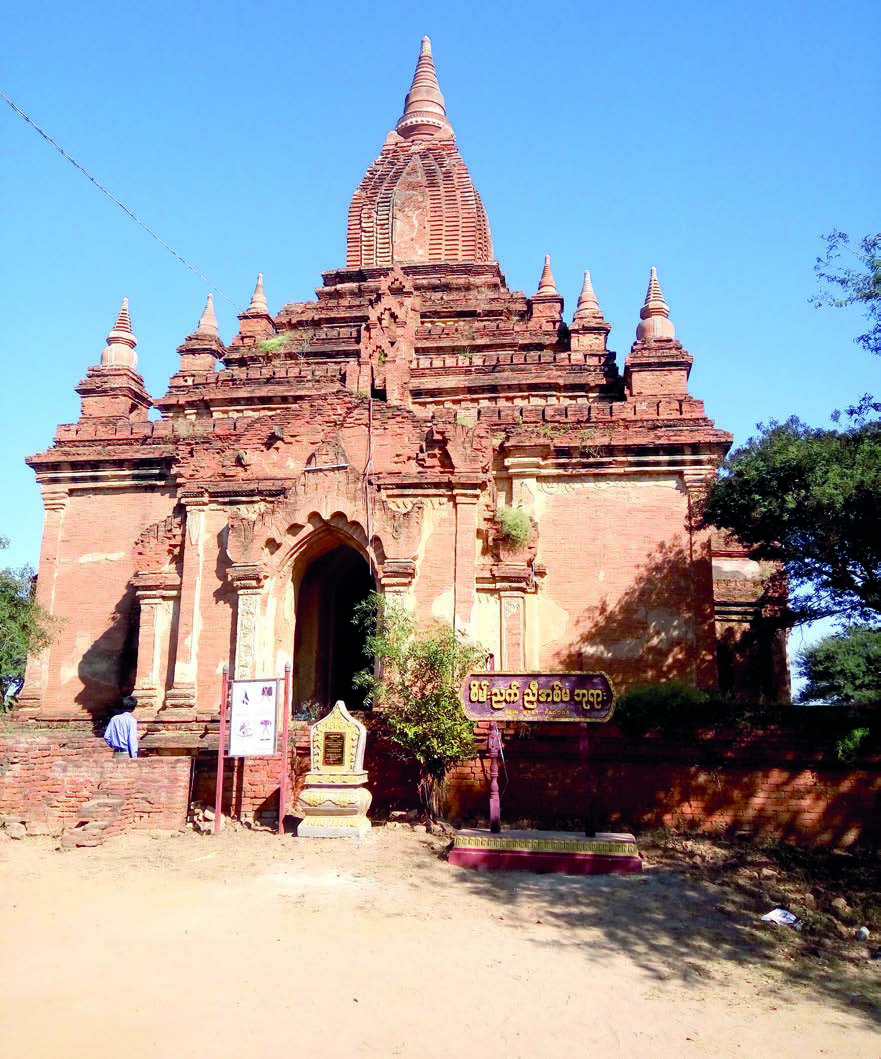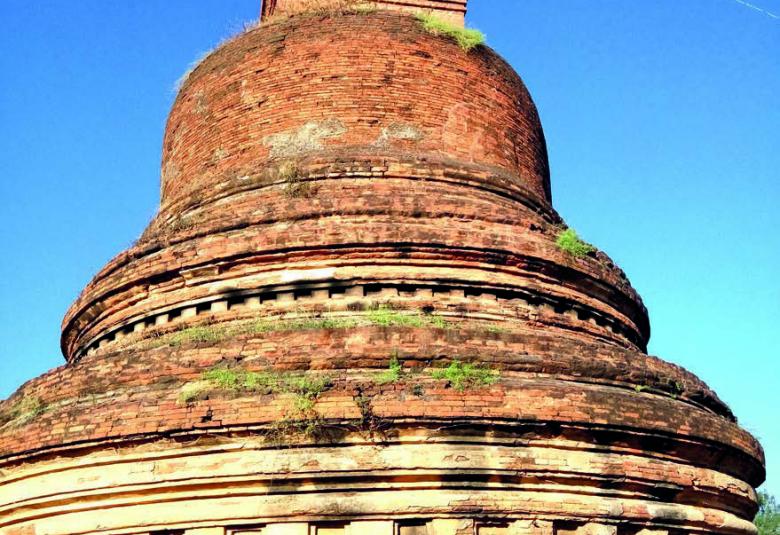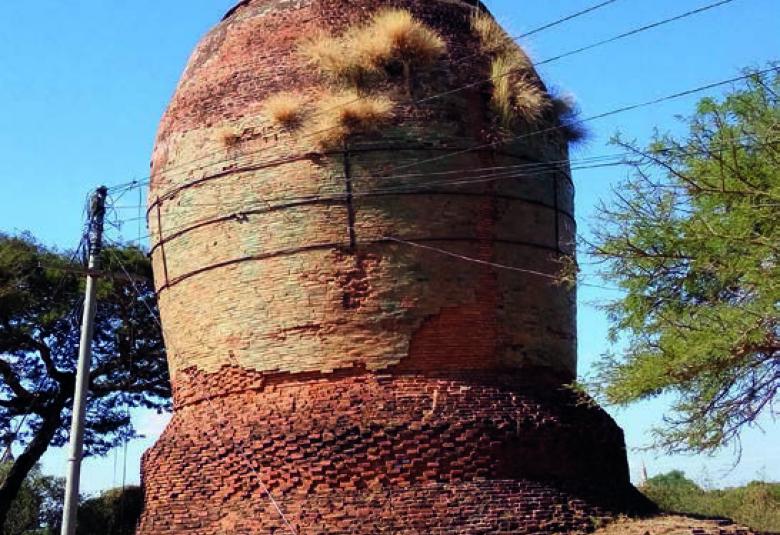By Maung Tha (Archaeology)
BAGAN region, a significant destination for local and foreign travellers, located on the bank of Ayeyawady River in NyaungU Township, Mandalay Region, is 13 kilometres in length and six kilometres in width.
The data of the Department of Archaeology and National Museum showed there were 2,217 temples and stupas in Bagan. With assistance of the UNESCO, French architectural expert Pierre Pichard counted 2,839 ancient temples and stupas in Bagan during the period from 1982 to 1991. After a powerful earthquake shook Bagan on 24 August 2016, as data on ancient pagodas, temples, stupas and ancient buildings in Bagan were collected, it proved there were 3,122 ancient edifices including mounds rebuilt in 1997-98 and unexcavated ones.
According to the statistics, there were 1,745 pagodas and temples, 431 brick buildings, 54 tunnels and ordination halls and 892 brick mounds in Bagan.
One- to four-storey cave pagodas, tunnels, one-storey temples, Pitakat chambers and ordinations, the buildings with cave and tunnel can be identified as Temples and those without cave and tunnel, as Stupas.
Stupas and temples in early Bagan era
New styles of stupas and temples in early Bagan era were slightly changed their forms from designs of stupas and temples in Sri Keatra era such as Bawbawgyi, Phayama and Phayagyi. Ngakywe Nataung Stupa in Bagan was similar to Bawbawgyi Stupa in Sri Kestra era.
Bawbawgyi Stupa was lack of the banana bud, inverted lotus flower, spreading lotus flower, high relief in circular decorative band and inverted bowl similar to current pagodas. Moreover, the pagoda was not hoisted the holly umbrella.
Ngakywe Nataung Stupa, No. 1603 edifice in Bagan ancient region, was built with the use of glazed bricks. Some experts assumed Ngakywe Nataung Stupa was built in 11th century AD.
Likewise, four pagodas in series located near the police station in new Bagan town are similar to the pagodas with the works of Pyu. But, the formers were decorated with flower-shaped diamonds on the terrace and concrete lotus flowers at the foot of the structure but these were not designed as the forms of pagodas in Pyu era.
Bu Pagoda, built in early Bagan era, fell into Ayeyawady River due to impacts of the earthquake which hit in 1975. The original Bu Pagoda was built on a terrace and the body of the pagoda was decorated with spindle-shaped pieces.
In excavating the foundation of Bu Pagoda to be rebuilt because of its damage in earthquake, Avalokitesuara statues of Bodisattha in Mahayana Buddhism and votive tablets with stretching hand postures were found in 16 feet deep underground area. Votive tablets and statues of spirits were of works in Pyu era.
The pagodas in Bagan built before 11th century AD were constructed as inverted bowl shapes on the terrace based on the circular foundation. These pagodas were simple with few decorations.
Pagodas in Bagan in 11th century AD
It was assumed that Lawkananda Pagoda, the third sacred tooth relic pagoda by King Anawrahta, was built in interim period between Pyu and Myanmar eras. It took samples in Myanmar handcrafts of Bawbawgyi Pagoda in Sri Kestra. It bore circular decorative bands with high relief. The foundation of the pagoda was in octagonal shape. Its structure was bell shaped one with circular decorative bands at its centre together with inverted and spreading lotus flowers and spindle-shaped pieces in harmony.
The architectural work of Shwezigon Pagoda built in mid-11th century AD was the best. The square shaped foundation of Shwezigon Pagoda was decorated with the pigeon houses in harmony with the bell shaped pagoda structure. The pagoda having five terraces was built on the top octagonal terrace. Four sides of the pagoda were installed with ladders, and four corners of terrace were encircled by small pagodas.
Pagodas built in Bagan in early 11th century AD were in bell shape based on octagonal terraces. These pagodas were in the style of harmonized decorations in 11th century AD with circular decorative bands, inverted and spreading lotus flowers and spindle-shaped pieces.
Architectural works at Myinkapa Pagoda in south of Gupyaukgyi Pagoda and Inn Pagoda in north of Dhammayangyi Pagoda were built in 11th century AD. (The UNESCO expert mentioned Inn Pagoda as works in 12th century AD.)
Pagodas in Bagan in 12th and 13th centuries AD
Hsapada, Seinnyet Nyiama, Dhammarazika and Sint pagodas were well-known as significant pagodas constructed in 12th and 13th centuries. These pagodas bore architectural style of Sri Lanka. The inverted bowl shaped or bell shaped structure of the pagodas were built on the terrace. The relief chamber called Hamika and the apex of architectural works were placed on the bell shaped one.
Five-dimension Dhammarazika Pagoda built by King Narapatisithu of Bagan was placed on the pentagonal foundation. Each dimension was facilitated with a ladder and a bronze chamber. Its circular decorative bands were slightly similar to Shwezigon Pagoda of 11th century AD.
Seinnyet Nyi-ama, one was temple and another, stupa, were formed as the bell shaped structure, Hamika and circular decorative bands on triple terrace. The basic structures were formed on triple terraces with Sri Lankan style encircled pagodas at the corners.
Sint Pagoda, west of Alodawpyae Pagoda, has the structure built of glazed bricks similar to Ngakywe Nataung Stupa. Each dimension of the pagoda was facilitated with a ladder which can reach the third terrace.
Slightly high terraces were placed under the pagodas in Bagan in 12th century AD with different styles of those from Sri Lanka. The majority of pagodas in Bagan were built in 13th century AD. Among them, some experts assumed Soemingyi Pagoda in 12th century in southern part of Myinkapa Village would be preliminary architectural works of Bagan’s pagodas in 13th century AD. The pagodas in 13th century were higher than those in 12th century. Mingala Pagoda took sample structures of Shwezigon Pagoda. Ngamyethna (five-faced) Pagoda, northeast of Mingala Pagoda, is a temple with two spiral stairs.
Temples in Bagan
Bagan has plentiful of temples, and preliminary architectural works of temples in Bagan were based on that of Bebe, Yahanta and Ashayzay temples in Sri Kestra.
Temples in Bagan in 11th century AD were Ananda, Pahtothamyar, Apei Yadana, Nagayon, Myinkappa and Gupyaukgyi. Generally, these temples were constructed with a single entrance. The pivot was rounded with the inner circular road in the Gandakuti Chamber.
Among the temples built in 11th century AD, Ananda Temple was decorated with the best architectural works dubbed as the best detailed handicrafts.
The two-storey temples built in the 12th century AD were Thabbyinnyu, Dhammayangyi, Culamani, Lawkahteikpan, Seinnyet Nyi-ama, Kheminga and Myebontha with arrangements of lighting for the interior parts. Small temples such as Lawkahteikpan were not built with the pivot but the main buildings were formed as Gandakuti chambers.
The foundation of Seinny et Nyi-ama Temple was more than three feet high formed with four arch entrances. Some assumed such temple was built by Queen Seinnyet in 12th century AD. Considering the architectural works, experts assessed the temple was of works in 13th century AD, according to the book with the title of historical Bagan temples and stupas. The temple had a pivot at its centre, rounded by the corridor. The structure was formed with arabesque floral works in convex arches and prayer arches. Seinnyet Temple was based on triple terrace. Sri Lankan style small pagodas were allotted on four corners of triple terrace at the betel vine shaped one-storey Seinnyet Temple. Exterior of the temple was decorated with concrete works in ornamental motif in stucco depicting ogres.
The temples built in 11th century AD had least lighting. The temples built in 12th century AD were facilitated a single archway. However, the temples built in late-12th century AD were built with side doors and windows for more lighting and ventilation inside the temples. The main buildings were formed as Gandakuti chambers without pivots. In 13th century AD, the temples were built as three-storey facilities.
In the 13th century AD, four-faced and five-faced temples and Wetgyi-inn Gupyaukgyi temple become two-storey structures taking sample from Maha Bawdi Pagoda in Bodh Gaya of India.
Thousands of temples and stupas in Myanmar are different from architectural works except basic constructional systems in successive eras. These diverse temples and stupas in Bagan are famous as cultural heritages of Myanmar.
Reference:
Guide to Research in Bagan (U Bo Kay)
Architectural works in Bagan era (Minbu Aung Kyaing)
Temples and Stupas in Bagan (Information Ministry)
Architectural works and fine arts at temples and stupas in Bagan (U Myo Nyunt)
Translated by Than Tun Aung






